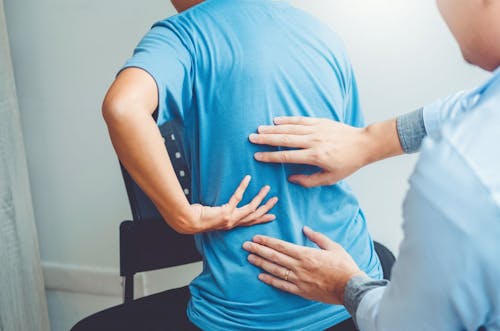Shockwave therapy is a multidisciplinary device used in orthopaedics, physiotherapy, and sports medicine that provides fast pain relief and restores mobility. It is an ideal therapy to speed up recovery and cure various indications causing acute or chronic pain. Contact Wasatch Physical Therapy & Rehabilitation Center today to find out more about our shockwave therapy and how we can aid you in your recovery process.
How does shockwave therapy work?
Acoustic waves with high energy peaks used in Shockwave therapy interact with tissue causing accelerated tissue repair and cell growth, analgesia and mobility restoration.
- New Blood Vessel Formation – Nutrient blood flow is necessary to start and maintain the repair processes of damaged tissue. The application of acoustic waves creates capillary microruptures in tendon and bone.
- Reversal of Chronic Inflammation – Mast cells are one of the key components of the inflammatory process. Their activity may be increased by using pervasive acoustic waves.
- Stimulation of Collagen Production – The production of a sufficient amount of collagen is a necessary precondition for the repair processes of the damaged myoskeletal and ligamentous structures. Shockwave therapy accelerates procollagen synthesis.
- Dissolution of Calcified Fibroblasts – Calcium build-up is most often the result of micro-tears or other trauma to a tendon. Acoustic waves break up the existing calcifications.
- Dispersion of Pain Mediator “Substance P” – Substance P is a neurotransmitter that mediates pain information through the C-fibers. This neuropeptide is generally associated with intense, persistent and chronic pain.
- Release of Trigger Points – Trigger points are the principal cause of pain in the back, neck, shoulder and limbs. Delivered acoustic energy unblocks the calcium pump and thus reverses the metabolic crisis in the myofilaments and releases the trigger points.
What Conditions Can Be Treated?
Shockwave Therapy can be used to treat a wide variety of musculoskeletal conditions, in particular, those involving areas where major connective tissue attaches to bone. Common sites that can be successfully treated are:
Jumper’s Knee
Jumper’s knee is an inflammation or injury of the patellar tendon felt as pain, tenderness and functional deficit. This condition may interfere with or even end your sporting career regardless age and is difficult to treat.
Shoulder Pain
Pain of the shoulder can be caused by e.g. calcifications, impingement syndrome or frozen shoulder and feel like a dull to severe pain and limit your daily life.
Tennis Elbow
Tennis elbow is a frequent condition occurring in up to 10% of the general population. Unfortunately the conservative treatment of epicondylitis is lengthy (rest), includes medication (pain killers, steroid injections) and often needs repetition. Shockwave therapy on the other hand offers a rather prompt pain relief and cure with efficiency of over 70% in just a maximum of 5 treatments.
Heel Spur
Calcium deposit on the underside of the heel bone (heel spur) is closely associated with scarring or inflammation of the plantar fascia (plantar fasciitis). Either of the indications or combined, can limit your daily activities.
Insertional Pain
Pain in the muscle insertions typically occurs due to repetitive or prolonged activities placing strain on a particular tendon.
Chronic Tendinopathy
Cumulated microtraumas from repetitive overloading can result in chronic tendinopathy (tendinitis or tendinosis). Tendinopathies at various areas of the body are a widespread diagnosis of both the active persons and the general population.
Medial Tibial Stress Syndrome
Medial tibial stress syndrome typically occurs due to activities placing large amounts of stress through the tibialis anterior muscle. These activities may include fast walking or running (especially up or downhill or on hard or uneven surfaces) or sporting activity (such as kicking sports). You are usually restricted from such activities for prolonged periods of time.
Calcifications
Calcifying tendinitis is a chronic pain disorder that is characterized by calcifications in rotator cuff tendons. Such condition causes pain and range of motion limitations.
Hip Pain
With age and use, the cartilage can wear down or become damaged. Muscles and tendons in the hip can get overused. The hip bone itself can be fractured during a fall or other injury. Any of these conditions can lead to pain and damage in the hip area.
What are the benefits of shockwave therapy?
Shockwave therapy has been known to:
- Quickly reduces pain
- No medication is needed
- Avoids surgery and anaesthesia
- No side effects
- No risk of allergies
- Accelerates healing
- Effective for chronic conditions
What to expect for a shockwave therapy treatment
Shockwave therapy is a non-invasive treatment. The application is simple and easy. Initiate therapy in 3 steps:
- Location of the area to be treated
The area to be treated is located using palpation in order to deliver the therapy precisely.
- Gel application
Sufficient amount of gel is applied to the area located in step 1. Use of gel is necessary to transfer the acoustic waves efficiently and smoothly.
- Therapy initiation
The Shockwave applicator is slightly pushed against the area to be treated and the start button is pressed.
Ready to add shockwave therapy to your treatment plan?
If you are in Millcreek, UT suffering from pain from an injury and would like to see if you are a candidate for shockwave therapy, contact Wasatch Physical Therapy & Rehabilitation Center to schedule an appointment and find relief today.


